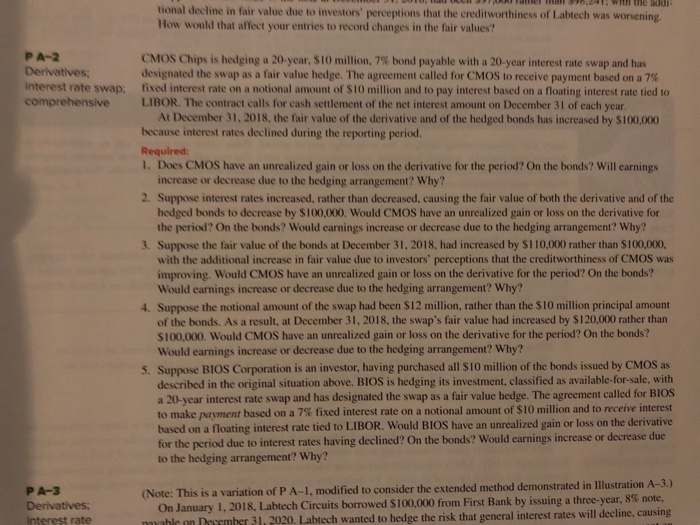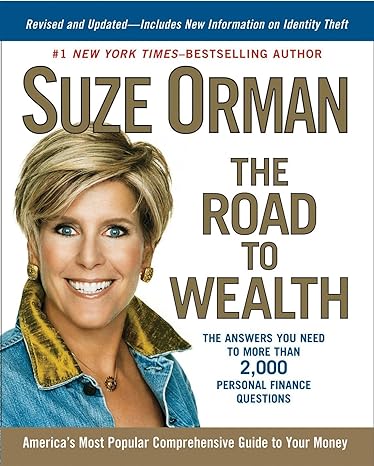tional decline in fair value due to investors' perceptions that the creditworthiness of Labtech was worsening How would that affect your entries to record changes in the fair values? PA-2 Derivative interest rate swap: comprehensive CMOS Chips is hedging a 20-year, $10 million, 7% bond payable with a 20-year interest rate swap and has designated the swap as a fair value hedge. The agreement called for CMOS to receive payment based on a 7% fixed interest rate on a notional amount of $10 million and to pay interest based on a floating interest rate tied to LIBOR. The contract calls for cash settlement of the net interest amount on December 31 of each year At December 31, 2018, the fair value of the derivative and of the hedged bonds has increased by $100,000 because interest rates declined during the reporting period. 1. Does CMOS have an unrealized gain or loss on the derivative for the period? On the bonds? Will earnings increase or decrease due to the hedging arrangement? Why? Suppose interest rates increased, rather than decreased, causing the fair value of both the derivative and of the hedged bonds to decrease by $100,000. Would CMOS have an unrealized gain or loss on the derivative for the period? On the bonds? Would earnings increase or decrease due to the hedging arrangement? Why 3. Suppose the fair value of the bonds at December 31, 2018, had increased by S110,000 rather than $100,000, with the additional increase in fair value due to investors' perceptions that the creditworthiness of CMOS was improving. Would CMOS have an unrealized gain or loss on the derivative for the period? On the bonds? Would carnings increase or decrease due to the hedging arrangement? Why? Suppose the notional amount of the swap had been $12 million, rather than the $10 million principal amount of the bonds. As a result, at December 31, 2018, the swap's fair value had increased by $120,000 rather than $100,000. Would CMOS have an unrealized gain or loss on the derivative for the period? On the bonds? Would earnings increase or decrease due to the hedging arrangement? Why? Suppose BIOS Corporation is an investor, having purchased all S10 million of the bonds issued by CMOS as described in the original situation above. BIOS is hedging its investment, classified as available-for-sale, with a 20-year interest rate swap and has designated the swap as a fair value hedge. The agreement called for BIOS to make payment based on a 7% fixed interest rate on a notional amount of si0 million and to recene interest based on a floating interest rate tied to LIBOR. Would BIOS have an unrealized gain or loss on the derivativ for the period due to interest rates having declined? On the bonds? Would earnings increase or decrease due to the hedging arrangement? Why P A-3 (Note: This is a variation of P A-1, modified to consider the extended method demonstrated in Ilustration A-3.) On January 1, 2018, Labtech Circuits borrowed $100,000 from First Bank by issuing a three-year, S December 3l, 2020. Labtech wanted to hedge the risk that general interest rates will decline, causing tional decline in fair value due to investors' perceptions that the creditworthiness of Labtech was worsening How would that affect your entries to record changes in the fair values? PA-2 Derivative interest rate swap: comprehensive CMOS Chips is hedging a 20-year, $10 million, 7% bond payable with a 20-year interest rate swap and has designated the swap as a fair value hedge. The agreement called for CMOS to receive payment based on a 7% fixed interest rate on a notional amount of $10 million and to pay interest based on a floating interest rate tied to LIBOR. The contract calls for cash settlement of the net interest amount on December 31 of each year At December 31, 2018, the fair value of the derivative and of the hedged bonds has increased by $100,000 because interest rates declined during the reporting period. 1. Does CMOS have an unrealized gain or loss on the derivative for the period? On the bonds? Will earnings increase or decrease due to the hedging arrangement? Why? Suppose interest rates increased, rather than decreased, causing the fair value of both the derivative and of the hedged bonds to decrease by $100,000. Would CMOS have an unrealized gain or loss on the derivative for the period? On the bonds? Would earnings increase or decrease due to the hedging arrangement? Why 3. Suppose the fair value of the bonds at December 31, 2018, had increased by S110,000 rather than $100,000, with the additional increase in fair value due to investors' perceptions that the creditworthiness of CMOS was improving. Would CMOS have an unrealized gain or loss on the derivative for the period? On the bonds? Would carnings increase or decrease due to the hedging arrangement? Why? Suppose the notional amount of the swap had been $12 million, rather than the $10 million principal amount of the bonds. As a result, at December 31, 2018, the swap's fair value had increased by $120,000 rather than $100,000. Would CMOS have an unrealized gain or loss on the derivative for the period? On the bonds? Would earnings increase or decrease due to the hedging arrangement? Why? Suppose BIOS Corporation is an investor, having purchased all S10 million of the bonds issued by CMOS as described in the original situation above. BIOS is hedging its investment, classified as available-for-sale, with a 20-year interest rate swap and has designated the swap as a fair value hedge. The agreement called for BIOS to make payment based on a 7% fixed interest rate on a notional amount of si0 million and to recene interest based on a floating interest rate tied to LIBOR. Would BIOS have an unrealized gain or loss on the derivativ for the period due to interest rates having declined? On the bonds? Would earnings increase or decrease due to the hedging arrangement? Why P A-3 (Note: This is a variation of P A-1, modified to consider the extended method demonstrated in Ilustration A-3.) On January 1, 2018, Labtech Circuits borrowed $100,000 from First Bank by issuing a three-year, S December 3l, 2020. Labtech wanted to hedge the risk that general interest rates will decline, causing







